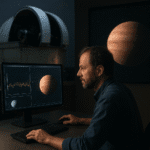Life aboard a spacecraft presents extraordinary opportunities and formidable challenges. Astronauts venture far from Earth’s comforting embrace, facing **isolation**, sensory monotony, and the constant demands of complex tasks. To thrive under such extreme conditions, they rely on robust psychological strategies, advanced **countermeasures**, and ongoing support from mission control and ground-based teams. This article explores the multifaceted approach that enables spacefarers to sustain **resilience**, mental **well-being**, and cognitive performance throughout long-duration missions.
Psychological Challenges of Deep Space Seclusion
Extended missions to the International Space Station (ISS), lunar orbit, or Mars entail prolonged separation from family, static environments, and tight quarters. Key stressors include:
- Sensory deprivation: Limited variety in sights, sounds, and textures can dull the mind and contribute to mood swings.
- Monotony and routine: Repeating daily tasks in an unchanging landscape heightens risks of boredom and decreased motivation.
- Confinement stress: Sharing cramped living spaces intensifies interpersonal tensions among crewmembers.
- Communication delays: On Mars-bound missions, lag times up to 22 minutes each way can exacerbate feelings of **separation** from mission control and loved ones.
Such factors challenge astronauts’ ability to maintain **focus**, effective decision-making, and emotional stability. Without adequate coping strategies, performance can decline and interpersonal conflicts can escalate, posing safety and success risks for the entire crew.
Rigorous Selection and Pre-Flight Conditioning
To ensure only the most adaptable individuals embark on deep space journeys, space agencies employ exhaustive screening and layered training protocols:
- Psychological evaluations: Candidates undergo personality assessments, stress resilience tests, and cognitive function challenges to predict their behavioral responses under duress.
- Team dynamics simulations: Crews participate in mock missions confined to Mars-like habitats or polar research stations, refining conflict-resolution skills and communication techniques.
- Virtual reality drills: Immersive VR scenarios replicate emergency repairs, equipment failures, and medical crises, enabling astronauts to practice rapid problem-solving in a low-risk environment.
- Mindfulness and biofeedback training: Techniques for breath control, concentration exercises, and heart-rate monitoring foster heightened self-awareness of stress signals.
These preparations build a foundation of **adaptability**, interpersonal trust, and cognitive agility that serves astronauts when they step into the vacuum of space.
Onboard Strategies and Daily Routines
Once in orbit or en route to another celestial body, maintaining a balanced schedule and implementing proactive **countermeasures** becomes vital. Crewmembers adhere to structured routines that integrate work, rest, and leisure:
- Physical exercise: Two-hour daily workouts on treadmills, resistive devices, and cycles preserve muscle mass and regulate mood through endorphin release.
- Leisure activities: Music, art supplies, and board games provide creative outlets and social bonding opportunities.
- Private time: Allocated periods for personal reflection or video calls with Earth help mitigate cabin fever.
- Environmental variation: Adjusting lighting schedules to simulate day–night cycles, using scented patches or tactile items, reintroduce sensory diversity.
- Structured communication: Regular video conferences with psychologists and family bulletins maintain emotional ties and offer timely support.
Collectively, these measures enhance **cognition**, reduce stress hormones, and foster team cohesion under the unique pressures of microgravity and isolation.
Leveraging Technology for Mental Support
As missions grow longer and reach farther destinations, technology assumes an increasingly central role in preserving astronauts’ mental health:
- AI-driven mood monitoring: Wearable sensors track physiological markers, feeding data to onboard algorithms that alert crewmembers to rising stress levels.
- Virtual reality escapes: Simulated walks beneath Earth’s forests or along familiar city streets offer brief respites from the metal confines of a spacecraft.
- Telepsychology services: Real-time counseling sessions bridge thousands of miles, employing secure video links even when delays pose challenges to natural dialogue.
- Digital journaling apps: Structured prompts encourage reflection, gratitude listing, and goal setting, reinforcing positive thought patterns.
- Interactive gaming platforms: Cooperative games strengthen teamwork and morale while providing lighthearted competition.
These innovations empower astronauts to remain vigilant about their mental states and to deploy targeted interventions before issues escalate.
Reintegration and Long-Term Mental Health Care
Returning to Earth’s gravity presents its own psychological hurdles. Crews often experience sensory overload, disrupted sleep, and shifting social dynamics. To facilitate a smooth transition, agencies implement:
- Debriefing sessions: Guided interviews and group discussions help astronauts process experiences, share coping techniques, and integrate mission insights.
- Rehabilitation programs: Physical therapy and gradually varied routines recondition bodies and minds to terrestrial environments.
- Mental health monitoring: Extended access to counselors and peer support networks ensures early detection of anxiety, depression, or readjustment difficulties.
- Research interviews: Collecting personal narratives and psychological data refines training and support for future missions.
Through these structured pathways, returning explorers reclaim life on Earth while retaining the **resilience** and skills honed in the silent expanse of space.
Conclusion
Maintaining mental health in the isolation of space demands a holistic blend of **rigorous preparation**, ongoing self-care practices, and sophisticated technological aids. By combining human adaptability with cutting-edge support systems, astronauts can thrive beyond our planet—and pave the way for safe, sustainable exploration of the cosmos.










